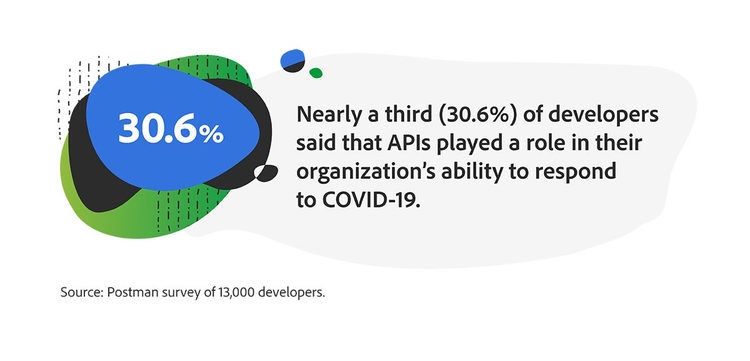How API-everything, developer creativity, and low code is the apex of IT agility
An agile infrastructure empowers IT organizations, developers, and LOBs to quickly design, customize, and integrate new and existing applications.

Image source: Adobe Stock / Tierney.
Whether you are a CIO, VP of enterprise architecture, or a front-end or back-end developer, meeting customer needs expediently means designing and fine tuning a technology infrastructure that can accommodate a wide variety of development options, including those that developers can use to unleash their creativity, and even for non-IT staff to contribute to the business of building business applications.
To that end, an agile customer experience management (CXM) stack is critical for organizations, especially to successfully weather — or even capitalize on — the kind of economic and business disruption we see today. A key characteristic of an agile infrastructure is that it empowers IT organizations, developers, and lines of business (LOBs) to quickly design, customize, and integrate new and existing applications.
In a survey of 13,000 developers, nearly one-third said that application programming interfaces (APIs) played a role in their organization’s ability to respond to COVID-19 by accelerating the development of new applications for working remotely, complying with new regulations, and more.

APIs improve productivity
The first step is to maximize use of APIs, which have been on an evolutionary path toward simplification, power, and flexibility. APIs are shaping enterprise architecture, and this has inspired how we approach them at Adobe: to enable an open, composable, and extensible customer experience technology ecosystem.
Built on RESTful (i.e. use HTTP requests to access and use data) APIs, Adobe Experience Platform exposes the full functionality of the system allowing IT organizations to be more creative, improve productivity, and complete custom software projects faster. Developers can access APIs and well-documented software developer kits (SDKs) to build apps around the data and make it securely available to virtually any third-party solution.
The combination of web-based APIs and open, standardized frameworks give developers freedom to build custom capabilities that get to market as fast as possible. In turn, developer teams can gain strategic influence in decision making, offering the most dynamic view of technology to business leaders.
It is no wonder that 79 percent of startups say they offer interesting tasks to attract developers to their organizations. “Software development isn’t just about knowing a programming language and writing code. It’s also about integrations — finding creative ways to solve problems, building on layers of services and APIs and getting the technology to all work together,” says Dave Weinstein, senior director of software development at Adobe.
Progressive web apps (PWAs) are another innovation that draws the talents of qualified UX and front-end developers. Such individuals are attracted to emerging web technologies like PWAs that offer opportunities for skills acquisition and career development. Based on a packaged suite of tools and component libraries built on open standards, PWA Studio in Magento Commerce is a developer platform that helps e-commerce brands deliver next-generation mobile experiences.
APIs and tools like PWAs empower developers and IT to be creative problem solvers. When lines of business and core functions like finance and sales face unexpected challenges or windows of opportunities, IT is often the first place they turn. Solutions may require developing or integrating new apps, swiftly.
Project Firefly
Project Firefly (currently in developer preview) is a complete design, application, and runtime environment that lets developers build and deploy custom, cloud-native web apps on our serverless platform, Adobe I/O Runtime. Together with Adobe web and mobile SDKs, these apps can be integrated with back-end systems that serve as the systems of record for organizations.
“Project Firefly is allowing our customer’s developers to be much more productive — solving problems in minutes and hours that used to take weeks and months,” says Weinstein.
Netcentric, a long-time Adobe customer that specializes in building digital experiences for a wide range of business clients, was one of the first companies to start working with Project Firefly. They created a demo website for a fictitious airline — Netcentric Airlines — to test out the then-new framework and better understand its benefits.
“Customers and partners can easily create custom solutions when they need to integrate Adobe solutions with other marketing platforms or in-house enterprise systems,” said Colene Chow, senior product marketing manager, Adobe I/O. “Firefly can also help when they need to customize certain workflows to fit their enterprise workflows.”
Here are other ways our customers are using Project Firefly and apps built on it:
- Give front-line sales and service staff instant access to multi-channel customer histories. Customers have built single-page applications (SPAs) that allow cashiers, customer service agents, and front-line sales staff to see the full marketing history of each customer. These apps make it easier for sales and service staff to provide contextually relevant advice and recommendations, which can increase sales and customer satisfaction.
- Connect data from multiple marketing systems. Customers have created apps that ingest data from multiple marketing systems and combine it for many different purposes. For example, data could be analyzed and delivered via custom reports, surfaced through a dashboard, or piped into customer-facing web sites.
- Streamline migrations. Adobe used Project Firefly to build an app that allows our customers to quickly migrate content assets from third-party digital asset management (DAM) systems to the Adobe Experience Manager Assets solution.
Learn more about common use cases for Project Firefly.
Low-code development
The final piece of the agility trifecta is low-code or no code development, which has been cited as a key method for allowing IT to work closer with other departments during the COVID-19 crisis. “By enabling IT to work directly with colleagues in other teams to manage digital projects, you can not only accelerate innovation but enable other teams to gain critical development skills,” according to a report. Citizen developers can help augment IT and developer resources to scale and deliver more apps in record time.
Some aspects of Adobe Experience Cloud could be considered a low-code solution even if it is enterprise-grade and customizable. Take Adobe Experience Manager, for example. Yadhunandan Sarangarajan, a full stack developer architect at Wipro Digital, recently put it through the paces and you can be the judge:
Is Adobe Experience Manager really a low-code / no-code platform? Sometimes. The truly low-code parts are digital asset management, content translation/localization, and maintenance on AEM cloud. If the requirements are not very complex, reporting, workflows, and integration with marketing products can also be low-code.
The world of digital forms, data capture and e-signatures to streamline customer enrollment and onboarding is yet another critical use case supported by low-code development. COVID-19 has accelerated the need to digitally transform, and technologies like Adobe Sign has helped power the conversion of paper-based, legacy workflows to 100 percent digital processes that prioritize CX.
Adobe Sign in combination with no-code partner solutions, such as from Microsoft, allow organizations to add functionality without burning additional development hours. Adobe Sign can be integrated into Azure functions using Logic Apps and, with the help of Microsoft Flow, IT and end users can add signatures, a form, or an approval process on a set of documents with no coding required. The combo of Microsoft PowerApps and Sign is also a low-code way to easily create interactive forms, capture signatures, and connect with different systems of record.
Enterprise developers is a focus
Supporting traditional creative pros and marketers as well as enterprise developers is a top priority. With the help of our customer and partner ecosystem, we will continue to explore and deliver tools that allow IT, software pros, and citizen developers to solve business problems and produce highly innovative apps that deliver valuable customer experiences at the speed of business change.
Check out the developer track and Firefly sessions at Adobe Summit 2021.